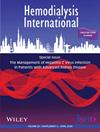The effect of massage on cramp frequency, cramp severity, and sleep quality of hemodialysis patients: A randomized controlled trial
Abstract
Introduction
Leg muscle cramps and compromised sleep patterns are prevalent issues experienced by individuals undergoing hemodialysis treatment. The aim of this study was to assess the impact of massage therapy on hemodialysis patients experiencing cramping, specifically focusing on the frequency and severity of cramps, as well as the quality of sleep.
Methods
This research involved 36 hemodialysis patients. The intervention group received intradialytic massage targeting the lower extremities, administered three times a week for a total of six sessions over a 2-week period. Data collection utilized a Patient Information Form, the Pittsburgh Sleep Quality Index, the Visual Analog Scale, and a Patient Follow-Up Form.
Findings
The study revealed a significant reduction in both the frequency and severity of cramps experienced by patients in the intervention group during hemodialysis sessions and at home, from the end of one session to the beginning of the next, compared to the control group (p < 0.05). This effect was observed over the course of six dialysis sessions. Additionally, there was a notable decrease in the mean total score of the Pittsburgh Sleep Quality Index (PSQI) among participants in the intervention group, declining from 9.00 ± 3.79 prior to massage therapy to 5.94 ± 2.84 post-massage (p < 0.001). Conversely, no significant change was observed in the control group, highlighting a notable disparity between the intervention and control groups in terms of sleep quality improvement.
Discussion
The investigation revealed that employing intradialytic massage on the lower extremities led to a reduction in both the frequency and severity of cramps, while also eliciting a positive impact on the sleep quality of patients undergoing hemodialysis.

 求助内容:
求助内容: 应助结果提醒方式:
应助结果提醒方式:


